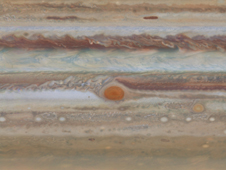Oct 19 2015
New maps of Jupiter, produced using images from NASA's Hubble Space Telescope, provide a detailed window on the giant planet's dynamic features. The views come as the agency prepares for its Juno mission to arrive at Jupiter in a little less than a year.
 Scientists produced new global maps of Jupiter using the Wide Field Camera 3 on NASA's Hubble Space Telescope. One color map is shown here, projected onto a globe and as a flat image. Image credit: NASA/ESA/GSFC/UCBerkeley/JPL-Caltech/STScI
Scientists produced new global maps of Jupiter using the Wide Field Camera 3 on NASA's Hubble Space Telescope. One color map is shown here, projected onto a globe and as a flat image. Image credit: NASA/ESA/GSFC/UCBerkeley/JPL-Caltech/STScI
The maps are the first in a planned series of yearly portraits of the solar system's four giant, outer planets, and are intended help scientists monitor how these worlds change over time.
The Jupiter maps are of particular interest to scientists working on Juno, which will arrive at Jupiter on July 4, 2016. "We've been coordinating with professional and amateur astronomers for several years now to collect observations that will help us plan Juno's activities once we arrive at Jupiter. The new Hubble maps are an extraordinarily valuable part of that effort," said Glenn Orton, a co-author on the paper from NASA's Jet Propulsion Laboratory in Pasadena, California.
Already, the Jupiter images have revealed a rare wave just north of the planet's equator and a unique filamentary feature in the core of the Great Red Spot not seen previously. They also reveal that the red spot continues its shrinking trend of recent years, becoming more circular and changing from red to a paler orange.
NASA | Jupiter in 4k Ultra HD
The Hubble observation program, called Outer Planet Atmospheres Legacy (OPAL), is led by Amy Simon, a planetary scientist at NASA's Goddard Space Flight Center in Greenbelt, Maryland.